
 |
|
|
|
Now, a copy of the booklet is in our hands and we can fill the gaps in adding the photos and images to the transcript, the images not belonging to the original publication will be identified in the captions. It is a work in progress, contributions are welcome, in the meantime enjoy.
Siamo riusciti a trovare una copia del libretto e adesso possiamo aggiungere le foto e le immagini alla trascrizione. Abbiamo aggiunto alcune immagini e queste saranno identificate nella descrizione. E’ un lavoro “in progress”, se volete contribuire siete i benvenuti, Scarperia, February 11th 2016, Andrea Gatti
AMERICAN "RAILS" IN EIGHT COUNTRIES |
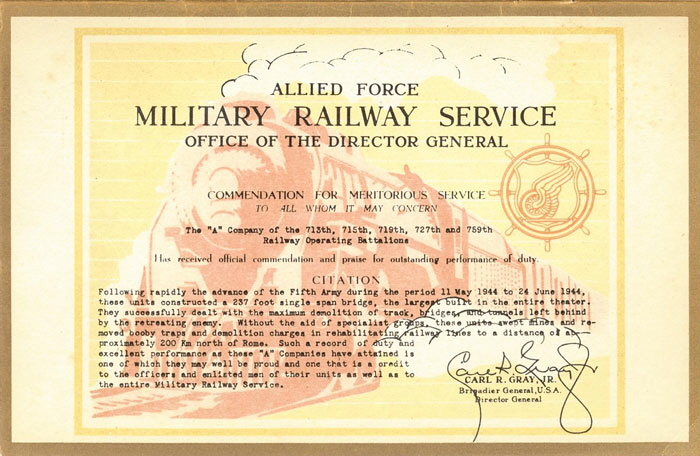 |
[Back of end page]
[p. 01]
GATHERED in one continent and moving over two seas and across two other continents, a mighty military supply organization has furnished men and material, bread and bullets for American forces of liberation in Africa, Sicily, Italy, France and now Germany. This organization first was known as the Services of Supply, North African Theater of Operations, later Communications Zone, Mediterranean Theater of Operations and now as Southern Line of Communications, European Theater of Operations. In direct command from the very start has been Major General T. B. Larkin, United States Army.
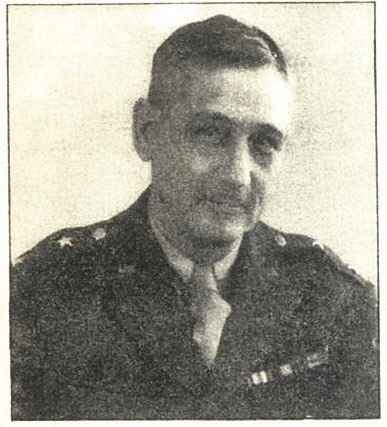 |
Gen. Larkin
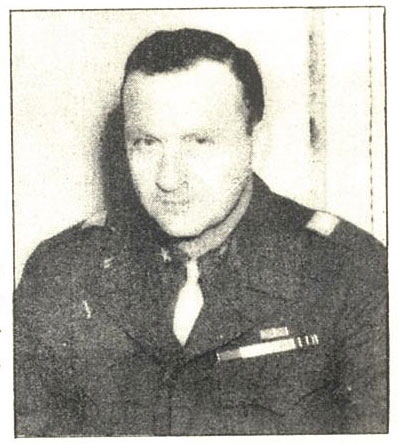
Gen. Stewart
First as the Chief of Transportation, Allied Force Headquarters -in Africa and Italy, and finally as the head of the highly important Transportation Section of General Larkin's Headquarters, is Brigadier General George C. Stewart of the Transportation Corps. He is responsible to General Larkin for the finely integrated task of planning, supervision and direction of the complex phases of all modes of transport, properly to support the field forces with the right supplies at the right time at the right place in the most appropriate manner.
His task involves the employment of great judgment in properly exploiting the means at his disposal, be they air, sea, waterways, highway or rail.
[p. 02]
The story of supply and service is graphically expressed in a Commendation by Lt. General Jacob L. Devers, Commanding General of the Sixth Army Group:
" In modern warfare, problems of supply are of prime importance; and consequently, the officers and enlisted personnel who, by their intelligence, their loyalty to duty, and their fortitude, have solved these problems throughout the present historical campaign, are deserving of enduring gratitude and of the highest commendation . . . . .
"The front line soldier is fully aware that, in order for him to receive clothing, food, guns and ammunition, he must be capably backed by hard working comrades. The arms and services must worth as a team. I know that you appreciate the magnitude of the sacrifices and the contribution which our front line soldier is making, and I am equally sure that he appreciates the noteworthy achievement of your forces."
But the story of supply cannot be told in one volume or a hundred volumes . For the benefit of the loyal men and women who have served in these highly essential duties and for the information of their loved ones at home, a series of SOLOC HISTORICAL BOOKLETS is being published.
This booklet concerns principally the activities of the First Military Railway Service which is under the command of Brigadier General Carl R. Gray, United States Army.
[p. 03]
PREFACE
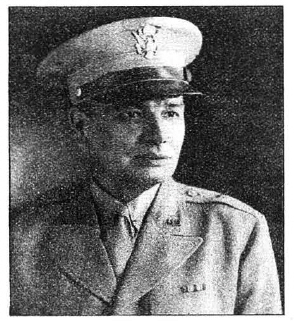
Gen. Gray
IT is with humble pride that I am permitted to preface the recital of the experiences of the some 6000 odd American railroad men whose active duty with the Military Railway Service began in the Summer of 1941.
Exploits of individuals and of Companies and of Battalions have been told, but this is the first opportunity to give a narrative running account of our moves form the United States through eight countries to Southern France.
The units of this command have more "whiskers" than any other units and to date they have had some remarkable experiences and have done a superb job of reconstructing and operating railroads under most difficult circumstances. Each country with its different customs and different conditions has presented a new problem.
As indicated, this story is not concluded with this booklet. We still have to follow the Armies into Germany and Berlin. We still have to add to our being called "Cheminots" and "Ferrovieris", "Eisenbanners", and when we have done that we hope to be able to go back and become American "Rails" again.
It has been an honor and a distinction and a pleasure to have commanded these troops. They merit your highest commendation.
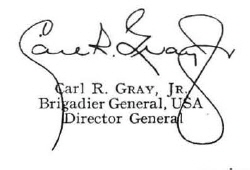 |
[p. 04]
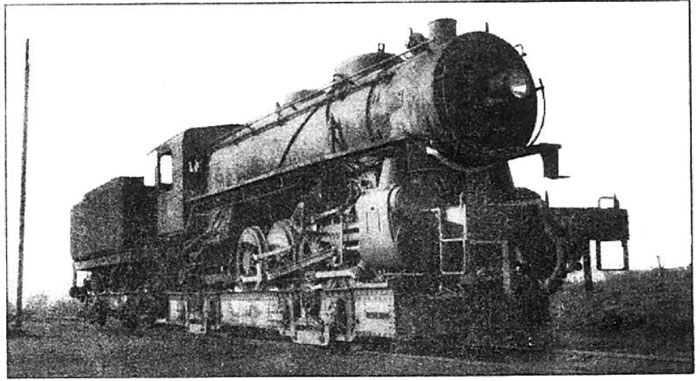
Photo Caption: Meter-gauge locomotive travels on well car
Three railroad locomotives peered down off the decks of a convoy pulling into the harbor at Oran, Algeria. Three 2-8-0s, built to government specifications by one of the nation's foremost locomotive makers. These triplets were close relatives. Since locomotives carry numbers, instead of the names their personalities really warrant, the three were names No. 1775, No. 1776, and No. 1777. This was North Africa, and North Africa meant war. War is a vast maze of uncertainties to men who approach it for the first time. but the three 1700s had one advantage - they were calmly certain that they would be in familiar hands. The men who were going to run them across North Africa were soldiers-with-adifference; men who had been accustomed for years to the weapons they were now using against the Axis.
These weapons were locomotives, cars, tracks, bridges, telephone and telegraph lines, repair shops; the men themselves, railroaders of the 1st Military Railway Service. Not many months before, these men were hoggers on the Atlantic Coast Line; firemen of the Southern; brakemen on the Santa Fe; machinists on the New York Central. Now they were welded together into the Military Railway Service [MRS], an integral part of the Transportation Corps and a formidable factor in war transportation. So while the 1700s may have felt some perfectly understandable trepidation in facing their part in the job assigned to MRS, to operate in combat zones and occupied areas, feeding troops and vital war supplies to the front line armies, yet they knew they would be in no amateur hands, and that if a locomotive could get any possible breaks, they would get them.
Now, MRS didn't just happen. Before the war it was an established peacetime reserve organization, its officer personnel sponsored by the railroads of the United States, and its enlisted reserve composed largely of veteran rails. Some of the units were organized in peace time, and a number of roads promised to sponsor new units in the event of war. Although set up along customary military lines, the MRS was patterned strictly upon orthodox railroad organization.
[p. 05]
The basic unit is the Railway Operating Battalion, made up of four companies. Headquarters Company has charge of dispatching, supply and signals. Company "A" takes care of maintenance of way and structures. Company "B" operates roundhouse and riptrack, making running repairs to motive power and rolling stock. Company "C" is the actual operating unit, with 50 train crews in charge of a trainmaster. A Railway Grand Division corresponds in scope and authority to a general superintendent's office on any American railroad, and typically has charge of the work of three or four operating battalions, a shop battalion and a base depot company. The Shop Battalion takes care of all the major repairs, construction and overhauling of equipment, and the Base Depot Company corresponds to a railroad Stores Department.
Since it was before their time, the 1700s didn't know that when Hitler began to expand his operations in 1939, MRS did likewise. With the declaration of hostilities in December, 1941, one battalion was already in training, and additional outfits were speedily organized thereafter. Their men came from every major railroad in America: in 1st MRS Headquarters alone, for instance, there were men from 34 roads. The Director General, Brigadier General Carl R Gray, Jr., was himself executive vice-president of the CStPM&O Ry. in civilian life. Headquarters of the MRS was activated at Fort Snelling, Minn. Many of the units trained at Camp Claiborne, La., where they built and operated the Claiborne and Polk RR (old "Crime and Punishment"), a line constructed by MRS and Engineer Corps troops specifically for training purposes. Other units trained at Clovis, New Mexico, Bucyrus Ohio, Camp Shelby at Hattiesburg, Miss., and other advantageous spots. The Southern Ry. System made its NO & NE line and employees available as schoolhouse and teachers for the 727th Railway Operating Bn., which was sponsored by that line. Similar arrangements were provided for the 759th Operating Bn. on the Missouri Pacific RR, and shop facilities were offered to the 753rd Shop Bn. by the New York Central at Bucyrus, Ohio; the 713th Operating Bn. trained on the Santa Fe at Clovis, New Mexico, and the 730th on the Pennsylvania at Fort Wayne, Indiana.
In addition to basic military training - life insurance for the railroaders - attempts were made to create conditions which would have to be faced in combat zone railroading - repairs to track and equipment, signals, blackout operation of trains, and so on - life insurance for the 1700s. The fall of 1942 saw the first dispatch of units of MRS to overseas destinations. The 761st went to England. The 702nd Railway Grand Division, 711th Operating Bn., 730th Operating Bn., 754th Shop Bn., and 762nd Diesel Shop Bn. went to Iran. The 770th Operating Bn. went to Alaska on the White Pass and Yukon RR. Subsequently the 714th Operating Bn. took over operation and maintenance of the governmentowned
railroad in central Alaska.
For other units, the 701st, 703rd, 704th, 713th, 715th, 719th, 727th, 753rd, 759th, 760th, destiny held in store hard campaigns and high honors in North Africa, Sicily, Italy, Southern France. Still other units, yet untrained, would make their marks on the beaches of Normandy and the race across Northern France. Perhaps we're anticipating our story a bit, but we must point out that all in all, the 1700s had a mighty ingenious and farsighted organization prepared for them as they waited on the convoy's decks for the big cranes to swing them onto Oran's docks and into the maelstrom of war.
[p. 06]
On the morning of November 8th, 1942, a war-sophisticated world was shaken wide-awake by the brilliant strategy of a bold and powerful bid to turn the tide of battle. North Africa was invaded. In the invasion force which landed at Casablanca, French Morocco, on D-Day, was an advance echelon of twelve officers and men of the 703rd Railway Grand Division from the United States. Simultaneously, the 761st Railway Transportation Company came down from England and went ashore at Oran.
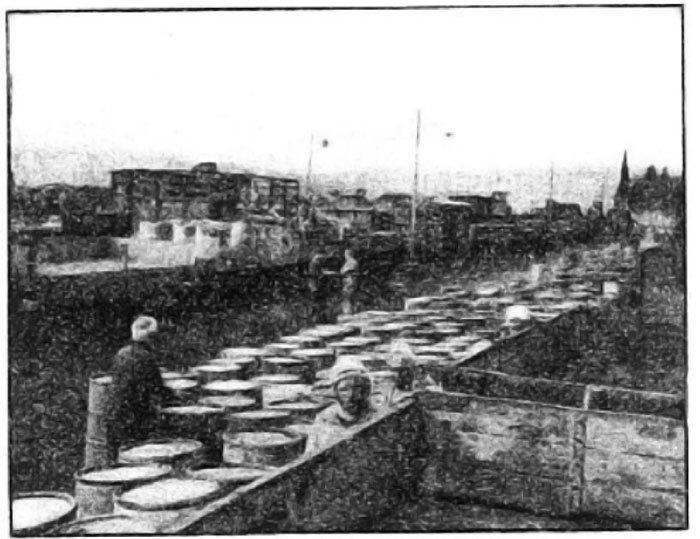
Photo Caption: Arabs transferring load from standard gauge cars to the meter gauge cars at Ouled Ramoun.
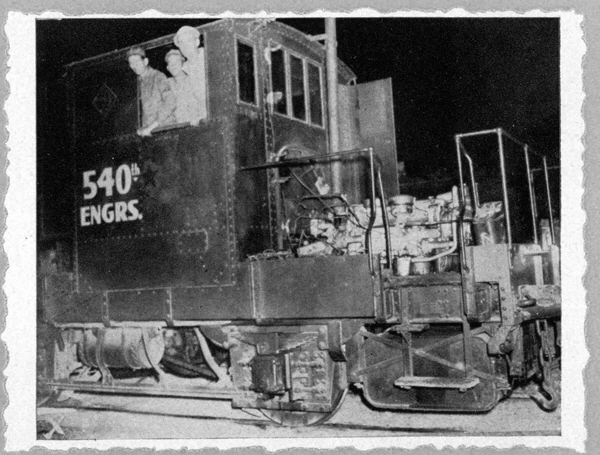
Men of the 540th Engineer Combat Regiment - North Africa - Photo courtesy of Marion J Chard
As the invasion troops pushed inland from the ports, these men immediately started organizing French railway employees and French railway equipment (the 1700s, remember, were still a gleam in a boilermaker's eye) to handle the necessary incredible quantities of military supplies up to the expanding battle lines. Coupled with some British Transportation troops who landed at Algiers shortly afterwards, the nucleus of MRS in North Africa was formed. In the tumultuous weeks that followed, more and more soldier-railroaders poured into the mounting offensive - the balance of the 703rd, the 713th and 727th Railway Operating Battalions, the 753rd Shop Battalion. General Gray arrived by plane with a small advance echelon of his headquarters, taking personal charge of operations.
These units spread out over the French railroad net, concentrating at strategic points, augmenting the civilian manpower, of the railroads handling and supervising the increasing load of military supplies speeding across the plains and djebels to the fighting front, where the doom of German and Italian hopes was being written emphatically in Tunisia. Now American locomotives and freight cars began to arrive at the ports: additional troops continued to arrive in a steady stream - the 701st Grand Division, the 704th Grand Division, the balance of MRS headquarters, the 715th, 719th, and 759th Operating Battalions. The 2682nd Base Depot Co. (which later became the 788th) was organized to handle distribution of railway stores and equipment.
With vast armies locked in battle, the sorely needed second front against the Axis was now an accomplished fact. Throughout the world the feeling grew that the turning point was coming. In retrospect we know that it had been reached. Now let's turn from the general to the particular and take a more intimate look at what these soldier-railroaders were doing about their own segment of the great over-all plan.
[p. 07]
It was tough railroading - like nothing they had ever seen in the States. Operating over some of the highest track in the world, MRS crews took their blacked-out trains of troops and high explosives, tanks and gasoline, roaring through the night without headlights, shooting through tunnels and across trestles, not knowing whether the track was still there or not; streaking down grades of 2 per cent and even higher, without air brakes, depending on sleepy Arabs to man the hand brakes at the right time. And many was the time, the Arabs kept right on sleeping. The 1700s had plenty of occasion for holding their breath.
There were many novel problems in those early days - problems which later became run-of-the-mill stuff for the railroaders. One of the first really tough jobs, ordered only a few days after arrival of the MRS in Africa, was the movement of fifty four medium tanks. There was no suitable equipment at hand. There had been no such movement on the railroad before. A lengthy search produced a few 30-ton flat cars which had been designed for handling steel rail, and some 60-foot. 40-ton cars, all sufficiently heavy, but not structurally suited for loading tanks. Another day-and-night hunt turned up a few tools and sufficient heavy timber and spikes to convert the car decks. The tanks went forward in time to meet desperate battle needs. Meanwhile, increasing numbers of American-built standard and narrow-gauge locomotives and big 56-ton war flats were arriving at the ports. They were shoved into service as fast as they could be assembled and tested. Meter-gauge engines were particularly important for the movement of supplies through eastern Algeria from Ouled Ramoun to Tebessa and beyond. These engines were shipped knocked down from the States, hauled 630 miles to Sidi Mabrouk, Algeria, and put together by the 753rd Shop Bn., which worked 'round-the-clock to get them out, the first two being assembled in the record time of 76 hours. Then they were loaded aboard well-cars and routed to Ouled Ramoun where they could be transferred to the narrow-gauge track.
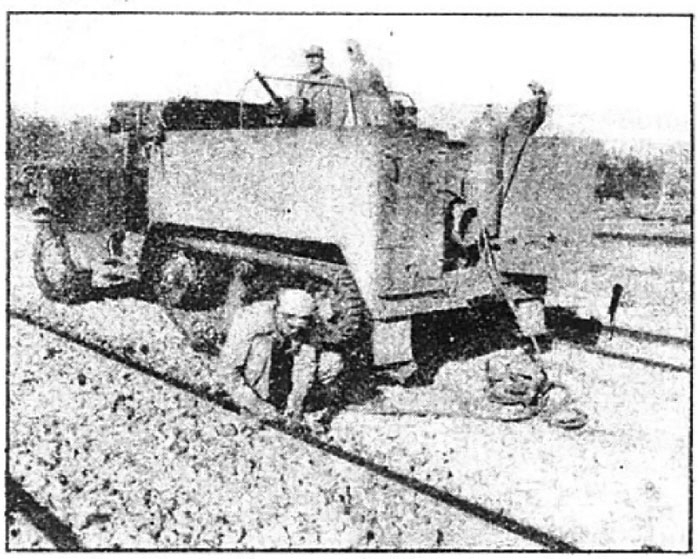
Photo Caption: Rail welders, with eye peeled for enemy aircraft.
As the full seriousness of the Allied threat in North Africa dawned upon the German command, and realization that the lines over which they were retreating would never be retaken, the railroads began to catch the full fury of Nazi demolition. As the German and Italian armies were forced back into their final corner in Tunisia, bridges were blown, roundhouses and shops destroyed, yard tracks made inoperative by blowing rails, switches and frogs, locomotives and cars destroyed or damaged by demolition charges and set afire.
[p. 08]
The job of repairing bridges, restoring tracks and machinery, and removing damaged locomotives and cars fell to the "A" Companies of the MRS Operating Battalions, assisted when necessary by Engineer Corps units. Main lines were quickly put back into use by "shoo-flys" around the demolished bridges; bulldozers shoved damaged equipment off the right-of-way; double-tracks were "cannibalized" to get enough undamaged rail to construct a sound single-line track; buildings were similarly made serviceable. So successful were these operations that at all times the railroads were able to keep up with the armies, laying down food, clothing, ammunition and gasoline at dumps but a few miles behind the lines of
combat.
This was no bed of buttercups - not even sunflowers. Hauling gasoline and ammunition is hazardous work even with all peace-time precautions. When sabotage, land mines, bombing and strafing come into the picture, the hazard is enormously increased. Dozens of MRS railroaders have been cited and decorated for bravery in fighting fires on munition and fuel trains, isolating burning cars, at the risk of their own lives.
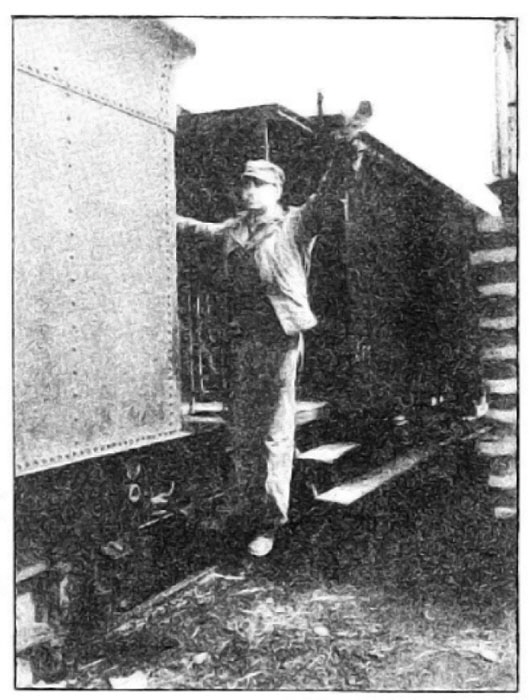
Photo Caption: Pvt. Ralph C. Cargo, Wheaton, Ill.
When several cars of ammunition exploded in a train at Maison Carree in Algeria one day, three men from the 753rd Railway Shop Battalion, although riding only as passengers on the train at the time, dodged exploding shells and burning gasoline to save what they could. The men were PFC Forrest Edwards, Elesmere, Del.; PFC Theodore Terpin, Buffalo, N.Y.; and Pvt. John Quinlan, South Amboy, N.J. Acting on their own initiative, the successfully uncoupled the rear portion of the burning train, grabbed a switch engine and pulled the undamaged cars to safety. Other trains on nearby tracks, loaded with gasoline and ammunition, also were removed from the danger area. For their courage, these men were decorated with the Soldier's Medal.
During these days, engine and train crews went out on their runs with their pistols and rifles handy. There were plenty of enemy demolition crews planted behind our lines by parachute and glider; blown tracks and bridges were encountered on lines previously reported clear, and many shots were exchanged in the dark with enemy wreckers. The Purple Heart decoration for wounds received from enemy action is by no means rare among the men of the Military Railway Service.
[p. 09]
The speed and audacity with which the soldier-railroaders attacked problems of operation and repair often startled the slower-moving natives. Wrecks which civilian railroaders estimated would block the line for ten days were cleared sufficiently to permit operation in three or four days. If it happened to be critically needed personnel and equipment moving at the time of the wreck, they were shuttled around the spot by truck and reloaded on trains on the other side. MRS would find the extra equipment somewhere, somehow. Combat conditions often caused MRS to shoulder jobs ordinarily not intended for this branch of the service. For example, the removal of land mines, booby traps and demolition charges along the railroad is ordinarily the job of the Engineer Corps, but during the stress of battle they are often too busy clearing a path for the advance of combat forces and can't give immediate assistance to the railroads. To prevent costly delay in the extension of rail supply lines, MRS troops themselves undertook to clear the lines of demolition devices, after thorough raining in mine removal and demolition technique was given to selected personnel of MRS units in the battle zone.
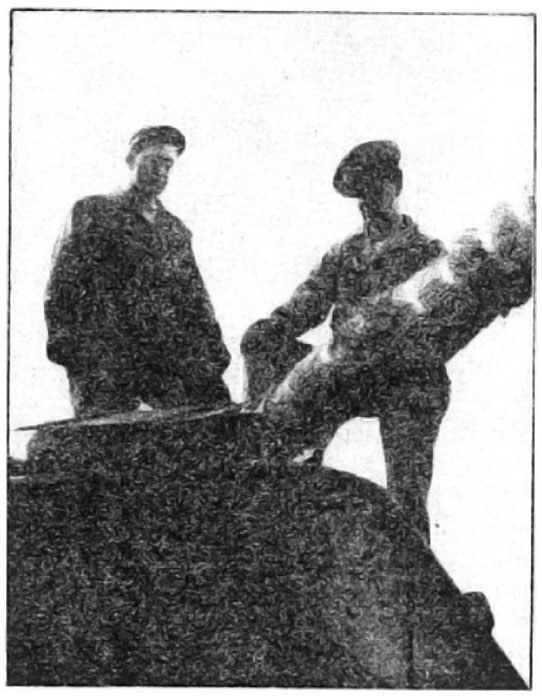
Photo Caption: Taking water from a typical North African water plug quite unlike those in the U. S.
Ordinary magnetic mine-detectors were generally useless on or near the tracks themselves, due to the disturbing influence of the steel rails. One method often used in checking a stretch of track newly taken from the enemy, was to push a flat car along ahead of a locomotive, thus detonating any pressure mines which might have been planted under the rails or ties. But for mines along the shoulders of the right-of-way, and delayed action mines under the track, it was a different story. They had to be located by probing for them with pointed sticks, and carefully dug out. In every new country where MRS railroaders go, they have to learn new languages, new customs, new national characteristics. And they must also try to teach the native railroad men a few angles of American railroading. T/Sgt. Robert Roe, a New York Central man from Ossining, N.Y., found himself supervising an Arab labor gang in Casablanca soon after arrival from the States with the 701st Railway Grand Division. The sergeant was assigned as Night Yardmaster at Casablanca, and soon discovered that the job required considerable patience with the Arab laborers handling railroad equipment at the port.
[p. 10]
One of his greatest difficulties was to familiarize the Arabs with the various parts of locomotives, box cars and flat cars. Not speaking their language, he resorted to signs. When he wanted car bumpers loaded, for instance, he would bang his fists together; for car springs, he would jump up and down like he was riding a pogo stick. The natives had a natural tendency to slip away to secluded spots for a siesta, so about every hour Sergeant Roe went around counting noses. to keep an effective gang at hand. The 1700s, meanwhile, were getting used to hearing the railroaders called "cheminots".
One of the problems in hauling military supplies over a long distance is to make sure that the ammunition, equipment, food and clothing actually reach the front-line troops who need them. It was this problem that brought a Military Police battalion into the MRS family in North Africa. With the attachment of the 794th MPs, commanded by Lt. Col. Frederick H. Owen, Augusta, Maine, the MRS assumed full responsibility for protection of supplies moving by rail. This arrangement was so successful that it was to become a permanent feature of MRS methods in future campaigns, additional Military Police companies being added as expanding operations demanded.
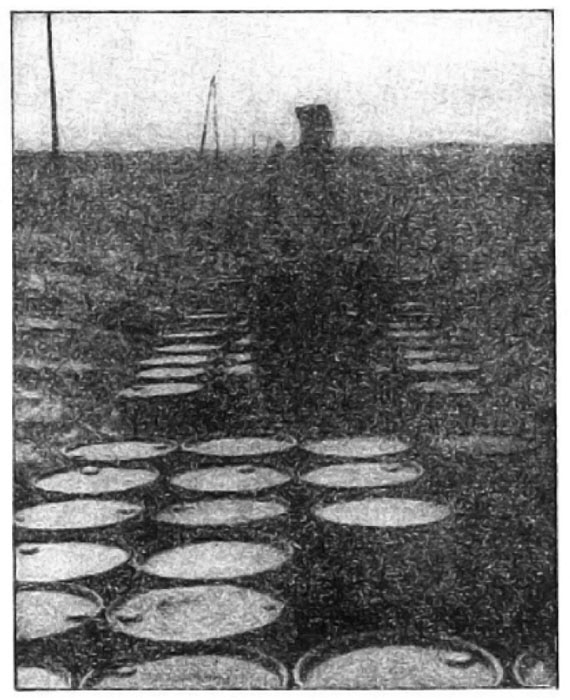
Photo Caption: W.O. Don F. Baker inspecting a train load of gasoline.
In North Africa the MPs rode the trains and guarded the yards across 1200 miles of rail line from Casablanca to Bizerte, living in the usual "40 and 8" box cars and eating personally cooked meals. Natives would board supply trains moving slowly up heavy grades, and would be collared by the waiting MPs before they could do any pilfering. Sometimes it was not so simple, however, and wild chases would take place over the tops of the swaying cars in the best of Wild West movie tradition. The men used their weapons only as a last resort.
The story of Kasserine Pass is one of the most famous in the North African campaign, and all through the American advance in January, 1943, and the fierce German counter-blow a month later, the Military Railway Service was right in the thick of it.
[p. 11]
For its outstanding accomplishments in the Kasserine and on through the Tunisian campaign, the entire 727th Railway Operating Battalion received a citation from General Gray. During the original advance through the Pass, personnel of the 727th reconnoitered the railroad ahead of the fighting line, and, under fire, recovered and removed a number of locomotives. Then, when the Germans counter-attacked with tanks, driving the Allies back, the 727th stayed to evacuate munitions and French troops. The last train left under enemy machine gun fire. Lt. Col. Fred W. Okie, from Birmingham, Ala., and a superintendent on the Southern Railway, personally led a detachment of his battalion beyond the Allied lines in an attempt to bring back two trains of ammunition which had been abandoned after a rapid enemy advance. When the enemy closed in and made removal of the trains impossible, Lt. Col. Okie and his men demolished the locomotives, gathered together a number of civilian refugees, and led them all to safety by a round-about route through the desert. When the Allies advanced again in March, men of the 727th helped repair the rail lines and rebuilt bridges in some sectors even ahead of the Army, always under hazard from bombing, strafing, and mines.
In North Africa, the ground war had burned itself out. The German and Italian Armies there had been destroyed or taken prisoner. But if the triplet 1700s figured they were due for a rest, they missed their guess. With no noticeable transition, they kept up their hard driving, preoccupied now with the preparation for the Sicilian campaign. On July 10, 1943, Sicily was invaded.
MRS soldier-railroaders quickly entered Sicily in support of Lt. Gen. George Patton's 7th Army. On July 13th, D-Day plus 3, an advance echelon of the 727th Railway Operating Bn. landed at Licata, reconnoitered the railroad yards, organized civilian rail workers, located equipment and made a pioneer run, all within four hours after they hit the beach. Twenty hours later, trains were moving into forward positions held by the Third Division, thus releasing many trucks for combat duties. The first day 400 tons of supplies moved inland; the second day 600 tons; the third day the 800-ton mark was passed, and continued to increase as the rest of the battalion arrived and went into immediate action on the captured rail lines. Mines were thickly sowed, and the veteran 727th hunted them out, permitting the Engineer Corps mine squads to devote all their energies to the clearing of paths for the combat troops' advance. Sabotage was encountered, trains were bombed and strafed and fired upon by ground troops, for as fast as a section of rail line was wrested from the enemy, it was put into use supplying the Third Division's battle line. The opening of the railroads and the organization of the Sicilian railroad personnel were made so rapidly and efficiently that rail service was immediately available in the Port of Palermo when it was opened on July 28th.
[p. 12]
Three hundred locomotives, 3,500 cars, and 1,373 miles of standard and narrow gauge right-of-way were the prizes captured in the Sicilian campaign. The equipment included a number of brand new German cars just ferried to the island. The Germans couldn't get them back to the Italian mainland after the ferry base was destroyed by Allied bombing.
Back at a water point in North Africa, the three 1700s, momentarily reunited, were piecing together the scraps of information they had picked up about the battle of Sicily, gossiping in that deep husky tone you'll find in idling locomotives the world over."... the things they say about those Sicilian locomotives! How do you suppose the 727th ever managed such a job without us! But you gotta admit that was one mighty fine job of railroading!"
By a strange coincidence, that same thought was running through the Head of Lieutenant General Patton. He cited the entire unit.
By this time our 1700s were getting to be battle-scarred, battle-wise old hands at military railroading, strategy and tactics - they were even learning to place a proper evaluation on rumors - so when the news broke that the battle was being carried on in Italy, they weren't much surprised. But one of the early news flashes from the Salerno beachheads really jarred their pony trucks.
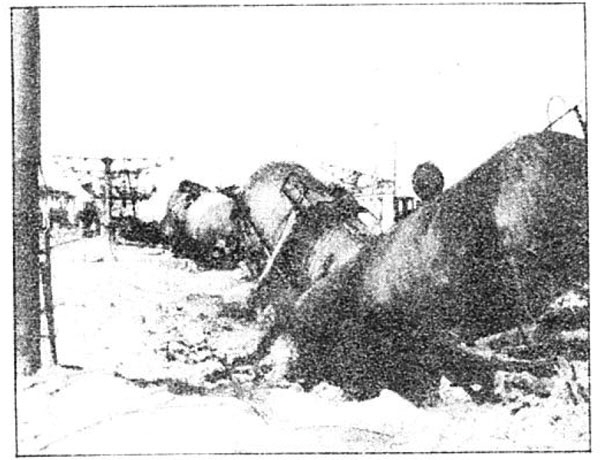
Photo Caption: Chaos in yards in Italy.
It was Colonel Clarence R. Burpee of the 703rd Grand Division (now a Brigadier General in command of the 2nd MRS) who fitted box car wheels to a couple of 6 x 6 trucks and put them in service as locomotives to haul the first trains of Allied supplies on the mainland of Europe. It is easy to understand that a blow this was to a 2-8-0. However, their turn was coming.
Colonel Burpee, who was named Deputy Director of Railroads in Italy by General Gray, began his on-the-ground work with the Salerno landings. An advance echelon of the 703rd landed in Naples on October 4th, and the 713th Operating Battalion went ashore at the same point two days later. The harbor was blocked, so troops and supplies had to go over the sides of ships into barges to be lightered into the littered docks and open beaches. The sight which met their eyes was one of utter devastation. What had once been part of one of the finest railroad system on the continent had turned into a heap of tangled scrap iron.
[p. 13]
The Germans, apparently realizing the tremendous part the railroads had played in their defeat in Tunisia and Sicily, had systematized their demolition of Italian rail facilities to a new high. Fleeing north from Salerno, they destroyed more than 25 bridges south of Naples. For them it was not enough to blow an occasional rail or switch. No - every rail, every switch and frog, had received individual attention.
As usual, the harvesting of mines was one of the first jobs. Even the unexploded charges had to be handled with extreme care, being equipped as they were with extra sockets for booby trap attachments.
Brakemen found nearly every switch mined to detonate when it was moved or thrown.
They took the mines out themselves. The broken overhead catenary hung uselessly from every pole, its wire ready to foul anything on wheels. It was necessary to cut the wires down before anything could move. Overhead bridges and foot walks which had been blasted onto the right-of-way had to be broken up and carried away before the ruined rails underneath could be replaced.
There was no general stores department to call upon for rail and fittings. A stock pile, if it could be called that, was gleaned from siding which could be spared for the moment. For long miles the right-of-way often failed to yield one useable piece of materiel. When the 713th first went to work in Italy, the enemy lines were only about fifteen miles away. It was almost impossible to find a building that had not been damaged, but after a couple of days in a brokendown warehouse the outfit located a more likely spot near the station and moved in. For two days they labored at cleaning the place up, only to learn that it was loaded with time bombs which might go off at any time. Needless to say, the building ceased to appeal to them as a bivouac.
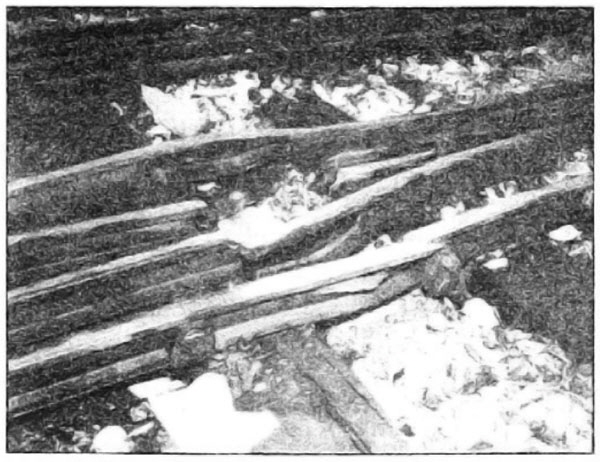
Photo Caption: Switches and frogs systematically blasted by Germans.
Yards were a sorry sight, due as much to accurate Allied bombing as to the thorough enemy demolition. Cars had been blown around like chaff in the wind, or stood in strings on the sidings, burned to a crisp, their frames standing like charred skeletons against the sky. But blowing a railroad into a state of total uselessness is a hard job, as the MRS railroaders set out to prove. Everybody pitched in - construction men, firemen, conductors, and all - to start cleaning up the debris, repairing track, and getting equipment rerailed and operating. On that word "everybody" hangs a tale: One of the 713th's operating platoons, led by Sgt. Fred A. Tomer, having nothing to operate at the moment, decided to become a track gang.
[p. 14]
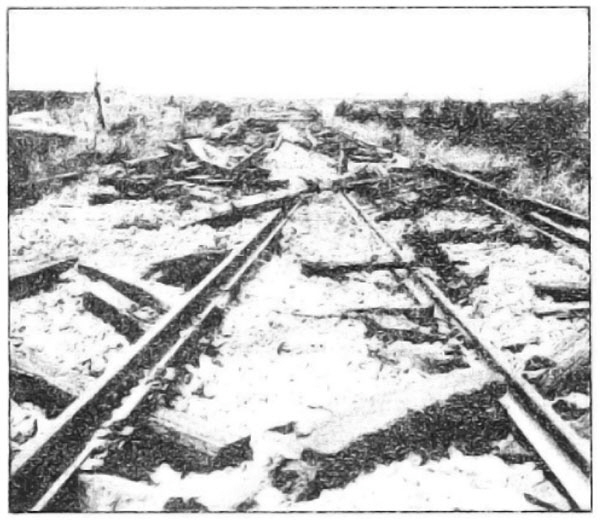
Photo Caption: Destruction on the right of way.
Now, Sergeant Tomer is ordinarily a conductor, so for a starter he had to give himself some new titles. He became, all at one time, track gang foreman, wreck foreman, and riptrack foreman. He grabbed Private Alexander Parker, who had some track gang experience, and made him right bower. Then the sergeant and his twenty-one men set to work early one morning. Firemen swung picks, and engineers wielded shovels. At dusk that night the gang had opened up a good length of track and put eight serviceable cars on it. They had filled in bomb craters so big that twisted cars lay in the bottom of them like so many toys. They had manhandled demolished rolling stock which hemmed in serviceable equipment, and had put a switch engine in operation.
Next day the gang reclaimed twelve cars and put more track back in service, filled more craters and fixed more switches.
The third day out, Sergeant Tomer looked behind a big mass of debris and spotted a German wrecker crane, not badly damaged. He and his gang put the crane in working order and then built 75 yards of track to get it where they could use it. From then on their work was a lot easier.
When the 1700s heard about that, they laughed fit to bust a flue, and their steam pressure went up alarmingly. But the laugh sounded pretty proud about something. When the track cleared up to the point where operations could be begun, the first train moved out to the nearby front. With the hazards awaiting the run, the crew was a big one. There were two engineers - T/4 William McMeans and T/4 Lyman Mills; two firemen - T/5 Alfred Ricketts and T/5 Paul Dahlin. The conductor was Sgt. Woodrow Boice, and PFC Harvey Bradley and PFC Victor Schaefer served as brakemen.
The first payload which headed up front was around 250 tons. In four days the trains were averaging 450 tons, and from there it went to 1,000 and more in short order.
But as extension of repair and control of the rail network progressed, hauling supplies from the ports to the forward areas wasn't the only big job performed by the Military Railway Service. Of equal importance was the evacuation of Allied wounded from the fighting front.
[p. 15]
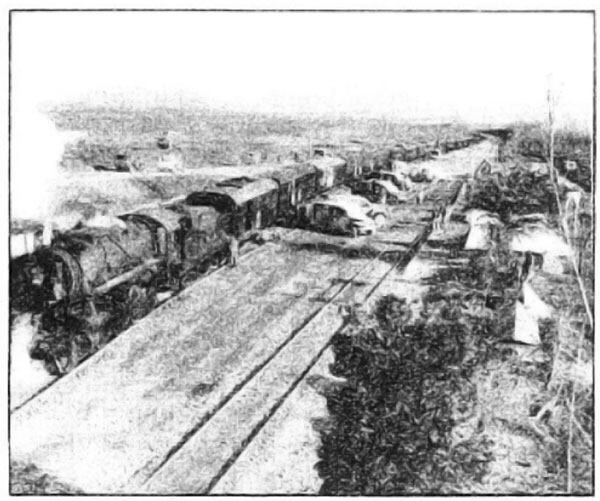
Photo Caption: Wounded soldiers board hospital train in forward area.
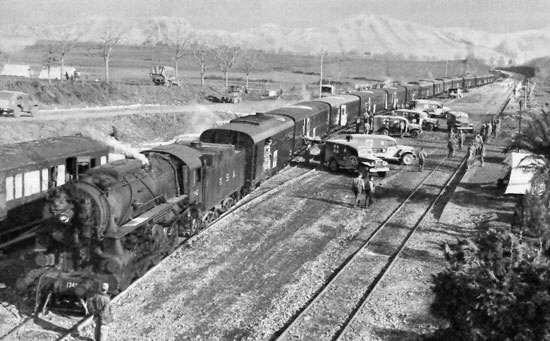
41st Hospital Train Loading near Riardo for Run to Naples, February 1944
It is a picture taken from [3]
Typical of the hospital trains assembled by the MRS was the "Mercy Special", which was put into service in Italy. It consisted of 14 cars, including four equipped for litter patients, four for walking wounded, one surgery and pharmacy car, one kitchen car, two sleepers for enlisted men and one for officers, and one boiler car to provide steam heat.
The initial run of the "Mercy Special" was an event of no small importance. When she arrived at the appointed place in the forward area, long lines of ambulances were waiting with cargoes of pain and suffering collected from evacuation hospitals even closer to the battle-grounds.
Working with the smoothness born of experience, the ambulance drivers backed their vehicle up to special outsize doors cut into the sides of the cars. Careful medical corpsmen unloaded the litters from the chilly ambulances. Inside, under the watchful eyes of a permanent crew of doctors and nurses, the wounded Americans were transferred from the canvas stretchers to tiers of beds with mattresses and springs, and provided with clean white sheets and blankets.
Meanwhile, the walking wounded were filing into cars set aside for them at the other end of the train.
A picked crew of the 713th Railway Operating Battalion was outside, making a routine check of the train, while a fascinated but subdued audience of Italian civilians looked on from the sidelines.
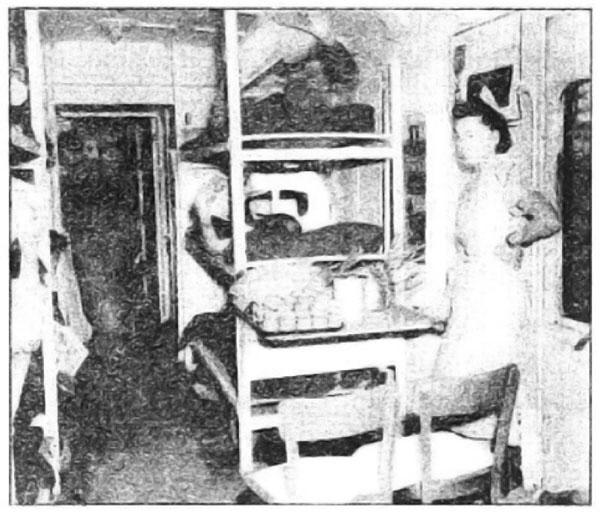
Photo Caption: Interior of a litter car on hospital train.
Then the conductor, Sgt. Henry Smith of Kansas City, Kansas, with 17 years of experience on the Santa Fe, gave the highball. T/4 Louis Waske of Conception Junction, Mo., off the Chicago Great Western cracked the throttle in the cab of 1775 ever so gently, and the train was off smoothly on its return trip. Even as she gathered speed over lines cleared of all traffic to wait her passing, the hospital train staff was going quietly about its duties. Army nurses checked every patient, and four doctors circulated constantly, especially in the litter cars carrying the more seriously wounded.
[p. 16]
In the kitchen car, a battery of cooks turned out a piping hot meal. and it was distributed through the train by GI waiters who navigated through the cars as though they were old hands at it. After chow, an American Red Cross girl came through with cigarettes and doughnuts and a cheery smile. Finally the special braked into her rear area station, to be met by a fleet of ambulances, and the wounded were soon on their way to a base hospital.
As we have seen, the 1775 had by now taken her second voyage at sea and was in service in Italy.
The '76 and '77 were, of course, broken hearted over the separation, but kept on plugging away at their jobs, as there was still much work to be done in North Africa, and many of the MRS units were still busy there.
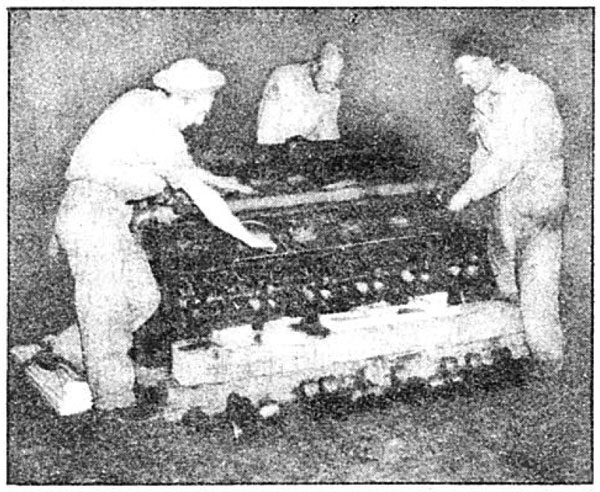
Photo Caption: Diesel mechanics overhaul an engine in Italy.
Over in Italy, an increasing number of Diesel-electric locomotives were being put into operation, and out of the Middle East came the 760th Diesel Shop Battalion to serve these less traditionally romantic but extremely useful rolling power plants. Although new in Italy, the 760th railroaders were "old hands over-seas", having served since November, 1942, on some 2,000 miles of line in Egypt, Syria, Palestine, Libya, and Tunisia. From the 760th, top-notch mechanics and electricians were farmed out to the other MRS operating and shop battalions to form diesel platoons in those organizations, passing on the broad experience they had gained, and, on the side, maintaining at white heat the question of "diesel versus steam".
That question hadn't been settled at last hearing, but it very definitely hadn't interfered with the integration of the efforts of the respective adherents.
Soldier-railroaders thought they had seen just about everything in the way of destruction after working their way across North Africa and well up into battle-scarred Italy, but they hadn't reckoned with Nature.
[p. 17]
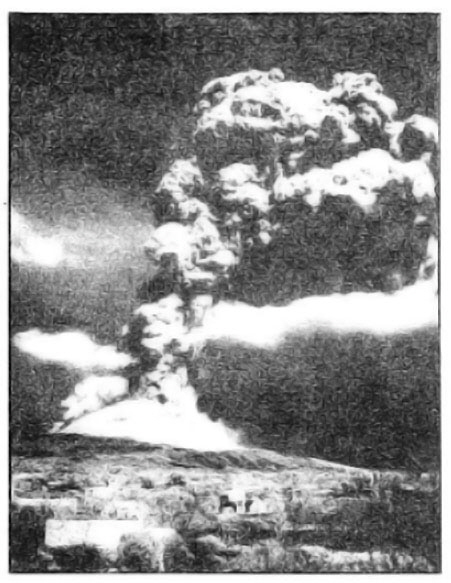
Photo Caption: Vesuvius blows its top.
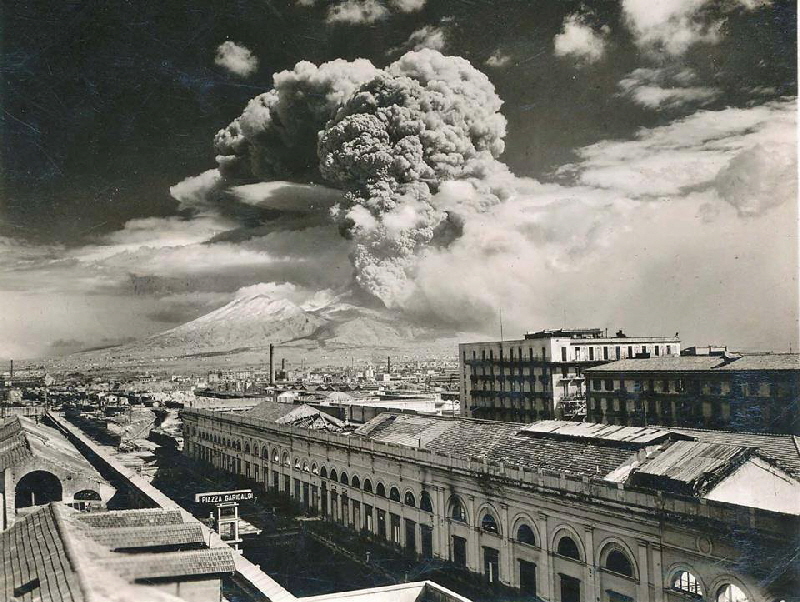
Vesuvius from Piazza Garibaldi Railway station - Photo Osservatorio Vesuviano Napoli
Along in March, 1944, old Mt. Vesuvius decided to stage one of its worst eruptions in many years.
Smoke shrouded the crater, red hot lava poured down the slopes, homes had to be abandoned, and a great cloud of ashes shot thousands of feet into the air. For a while the MRS train crews eyed the overcast sky with more curiosity than alarm. But finally it became necessary to turn freight trains back because of the ashes and cinders falling on the tracks - as deep as 20 inches in some spots. Pieces of cinder six to eight inches in diameter fell along the right-of-way as much as four and five miles from the volcano. Hundreds of MRS personnel dropped all other duties and went out with shovels, brooms and bulldozers to clear the track.
The ashes fell so fast that frogs and switches would fill up again as fast as they could be swept clean. Rain came down, and soon packed the cinders so tightly between the rails and switches that it was necessary to dig them out by hand.
"What'll they think of next," thought the 1775 as she bucked her way along by inches, with the crew getting down out of the cab from time to time to shovel a path for her as they went.
Apparently Vesuv' couldn't think of anything more, and having shot his bolt gradually quieted down and railroading became a bit more sane again.
MRS met lots of unexpected things in North Africa and Italy, and it wasn't surprising that a great many of them were of an unpleasant nature. But they weren't all of them on the dark side, and one of the brightest was Lt. General Mark W. Clark's presentation of the Fifth Army Plaque and Clasp to General Gray in recognition of the effectiveness of MRS operations in support of the Fifth Army's great fight up the Italian boot.
"I have regarded with mounting admiration the operations of the Military Railway Service in its support of the fifth Army," said General Clark. "In planning, construction and operations, the MRS has habitually performed the impossible. Despite clever enemy demolition, your engineers have executed nearmiracles of reconstruction."
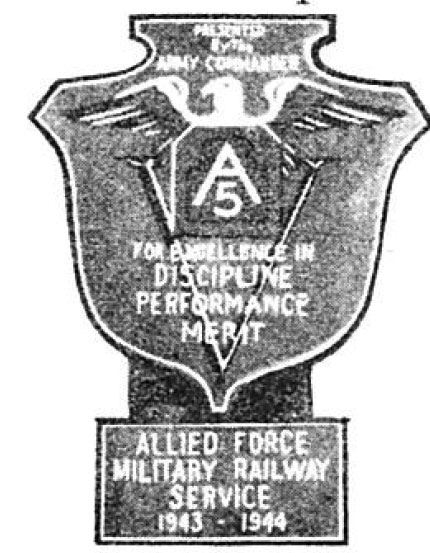
Photo Caption: 5th Army Plaque and Clasp presented to MRS by Lt. Gen. Mark W. Clark [Inscription reads:
"Presented by the Army Commander / For Excellence in Discipline Performance Merit / Allied Force Military
Railway Service 1943 - 1944"]
[p. 18]
"With unswerving concentration on the task ahead, your officers and men have labored, often under fire, in planning, constructing and operating the rails to the forward areas, virtually to the Army front lines. Time and time again, crucial materials and reinforcements could not have been brought into action except for the outstanding performance of the Military Railway Service."
Well ... '75 was pretty hard to get along with for a while after that. And when she heard about General Gray's reply to General Clark, expressing his "personal gratification for your recognition of the fine railroad soldiers I have the pleasure and honor to command," she nearly blew a cylinder head. "Paste that to your crownsheet," sez '75. "Oh, my aching drivers," said '76 and '77. But they made sure it didn't sound convincing.
First Train To Rome
On July 4th, 1944, one month to the day from the time the first Allied soldiers fought their way into Rome, the first train from Naples rolled into the capital city of Italy with General Gray himself at the throttle on the last stage of the journey. Accompanying the General on this historic trip was Henry L. Stimson, U. S. Secretary of War, and party. General Gray had with him his two Allied deputies, Italian General Giuseppe di Raimondo and British Brigadier R. D. Waghorn.
This pioneer train was a freight, and it carried all the coal that a pair of husky Diesel-electric locomotives could haul on a long string of cars - coal which was so sorely needed in Rome to help boost the output of electricity and gas. The Eternal City had long been without full public utilities service. When the Germans left, they wrecked the main hydro-electric plant which furnished most of the power for the city, and either carried away or destroyed all the coal they could find. So the first train, loaded with fuel, was received in Rome with joy and appreciation.
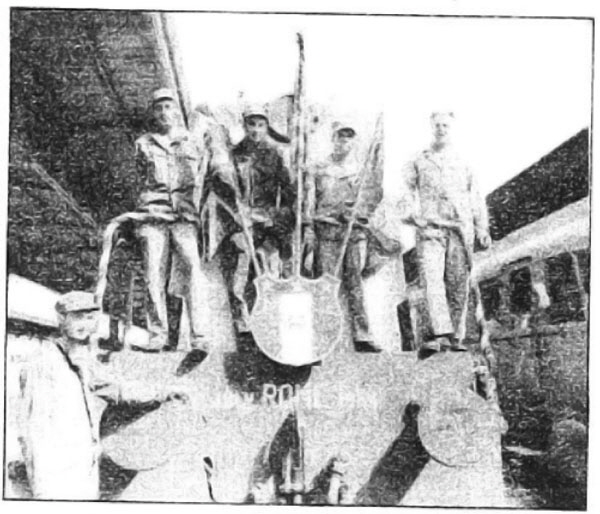
Photo Caption: Crew of the first train into Rome, July 4, 1944.
A month later, in August, came another "first run" for the MRS - this time from Rome to Arezzo, following the rapid advance of the combat troops. Through ghost towns, their inhabitants evacuated, their homes rubble, the Arezzo special felt its way along newly laid track and over spidery trestles hastily constructed where the Germans had blasted out bridges. Frequent stops were necessary for the crews to untangle the wires of wrecked catenary which became entangled in the wheels.
Bomb craters were frequent along the right-of-way, and the charred and riddled remains of German and Italian rolling stock were mute evidence of the effectiveness of Allied air attacks.
[p. 19]
Tunnels had been blown in by the Krauts and the debris clearly away only enough to permit operation of the track.
On this trip, as on many others, the ingenuity of the MRS railroader came to the fore. A car developed a hot-box and, in the absence of orthodox "dope", the box was repacked with a mixture of diesel fuel oil and GI soap. The journal completed its run in a state of exemplary coolness.
It was also in August, 1944, that the "A" Companies of five operating battalions - the 713th, 715th, 719th, 727th and 759th - were cited by General Gray for outstanding accomplishments in the repair and reconstruction of railway lines in Italy.
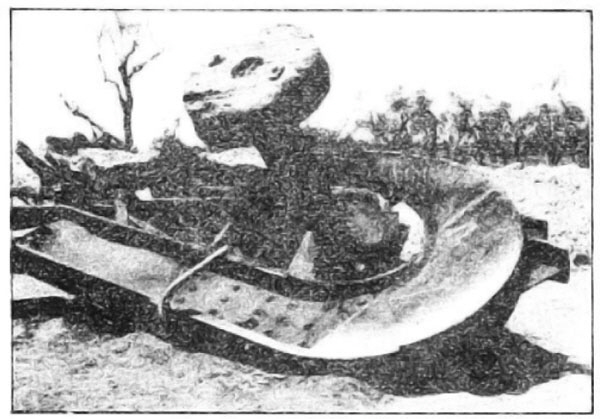
Photo Caption: The German "Big Hook".
The German name is “Schienenwolf”: the “Rail Wolf”
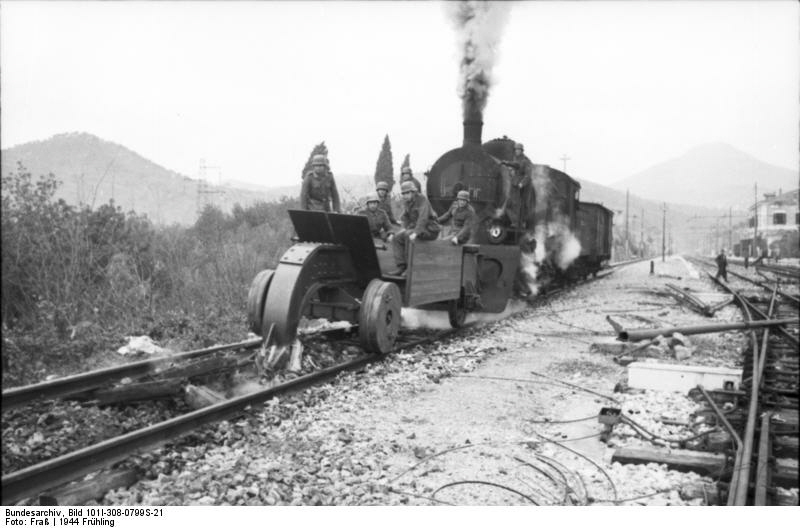
The German “Big Hook” in action at Itri Italy - Photo Bundesarchiv - Bild 1011-308-0799S-21
The Italian railways were very vulnerable to demolition. They abound in long high viaducts and steel spans, and in tunnels. The Germans made full use of this fact. They left in their wake a succession of bridges blown to rubble and tangled steel, and tunnels blocked by earth fallen from demolitions in the roof. In addition the plowed up the track by means of a giant hook towed by a locomotive and cut every rail in two or three pieces by explosive charges.
Keeping up to the Fifth Army in its swift advance, these maintenance of way outfits cleared wreckage from the tracks, bridges and tunnels, swept mines and removed booby traps without the aid of the Engineers, and put the rail lines back in operating condition. One of their outstanding achievements was the construction in 17 days of a 237-foot single span bridge over the Garigliano River - largest single span in the entire theater of operations.
Figures sometimes bring facts into startling focus. During the five months ending October 1, 1944, a total of 21,759 trains were required to carry over 7,000,000 tons of military freight to Allied Armies in Italy.
To accomplish this Allied Force Military Railway Service operated 2,478 miles of railroad, assisted by Italian personnel. Over 1,000 miles of that track had to be rebuilt, 450 miles of it being totally demolished and 650 miles badly damaged by bombing and shellfire. A total of 3,154 troop and 812 hospital trains were run during that period. Over 15,000 feet of new bridging built; 24 tunnels with a total length of 20 miles reconstructed; half a million cubic yards of earth moved for filling craters and gaps in viaducts over dry beds. Over 750 miles of signal routes repaired or rebuilt.
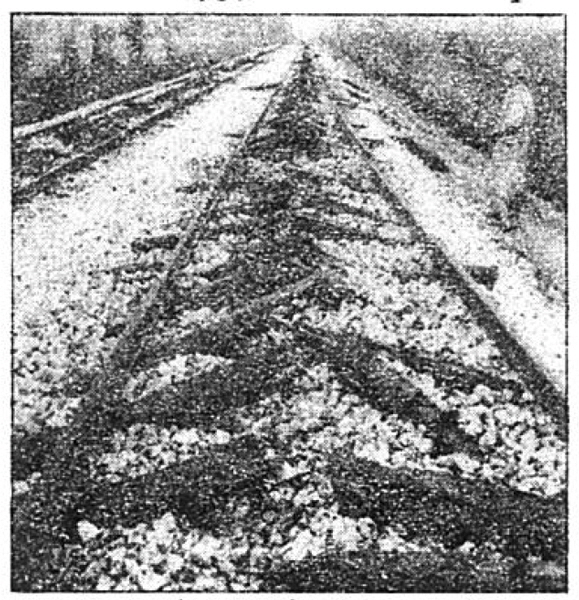
Photo Caption: ... and some of it's dirty work.
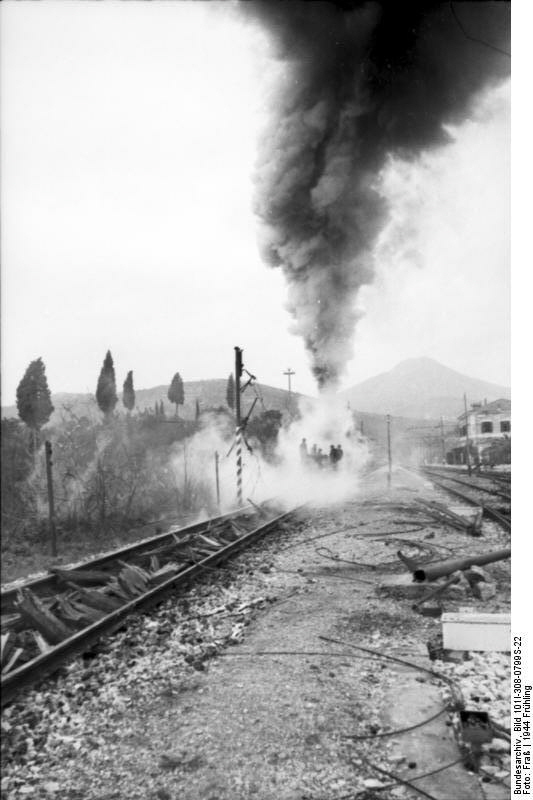
Itri Italy, the “Rail Wolf” destroyed tracks - Bundesarchiv Bild 101I-308-0799S-22
[p. 20]
Multi-photo caption
This page of photographs tells a story in pictures of construction work on the 237-ft. Garigliano river bridge, largest single span bridge erected by the MRS in Italy.
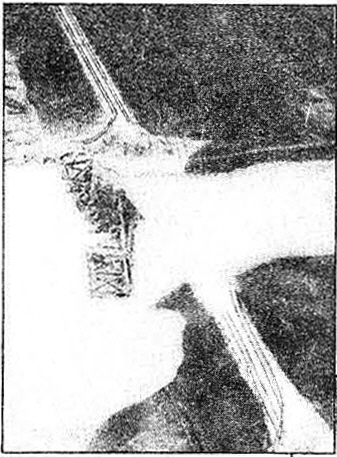
Company "A" bridge platoons started from scratch, as demonstrated in the aerial photo at top left.
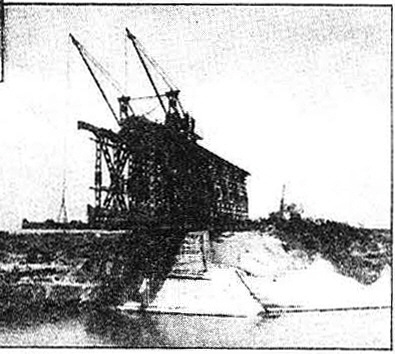
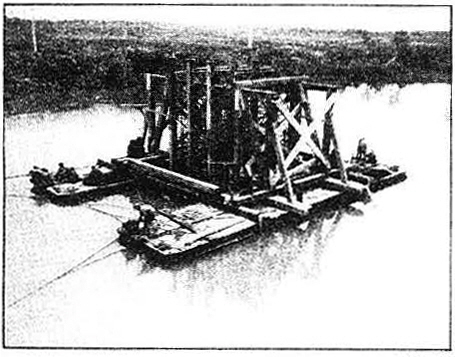
First task was to build a counterweight on the abutment, from which cranes could set out steel as shown in center photo. A temporary pier was then floated out to carry the load.
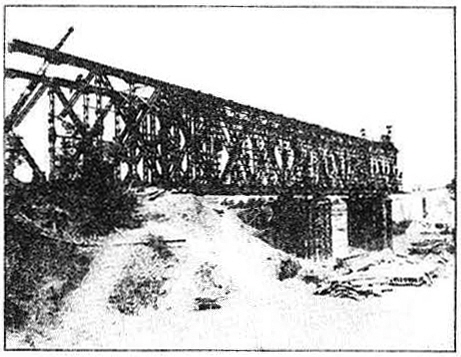
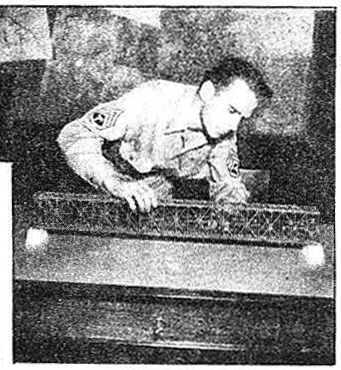
German steel, captured from the retreating enemy, was used on the Garigliano river bridge. Plans were drawn for it at MRS H.Q., and T/3 Owen Beckwith, Minneapolis, Minn., became so interested that he went to work on a scale model which he made out of cardboard, match sticks and glue.
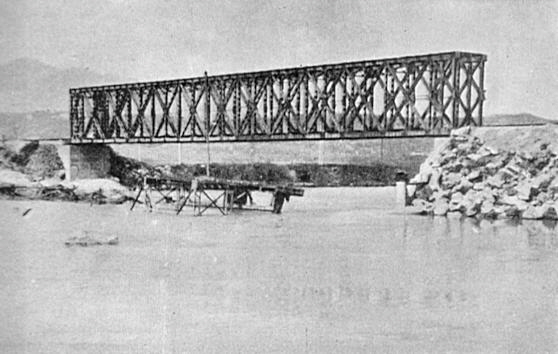
Line 89. The Garigliano Bridge South of Minturno. Ref. [4]
The repair was carried out by 713, 715, 719, 727 Rly, Optg, Bns. U.S.A. under Job Nº. 89/40, from 6 May 1944 to 5 June 1944. This bridge is the longest single span railway bridge erected by the Allies in Italy. It is a 72 meters Roth Waagner structure of captured enemy materials. Ref. [4]
[p. 21]
In Italy the 794th Military Police assumed a new role of importance in addition to their guarding of trains. This time it was radio. Spread over a constantly widening territory where ground communication was uncertain at best, the MRS found the 794th radio to be a life-saver. The MPs themselves had little detachments scattered hither and yon. First radio connections in Italy were set up between Salerno and Naples. Stations were later added at Benevento and Aversa, and the number continued to increase as the campaign advanced.
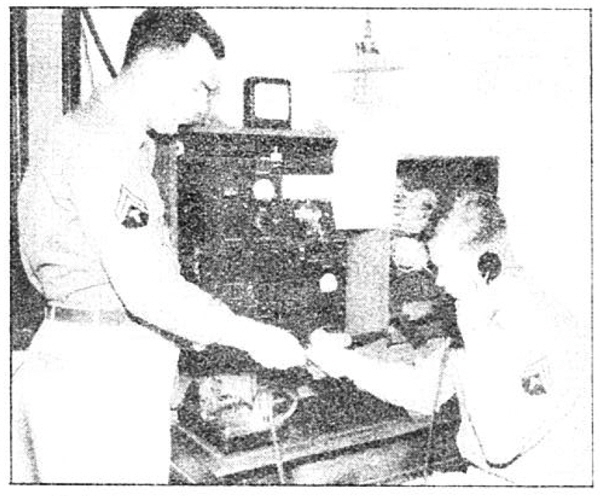
Photo Caption: Radio room handles hundreds of messages daily.
When the big push came, and Rome was liberated, the MP radio took on another value as a means of communication between Naples and the capital city before telephone and telegraph lines had been restored.
Leading up to the British offensive on Italy's east coast, the 79th set up a radio station at Falconara in the Ancona sector and provided the only direct means of communication between that area and the British transportation officials in MRS headquarters.
General Gray's special rail car was radio-equipped so that while on the road he could keep constantly informed of happenings back at headquarters. So valuable was this new field of service on the part of the MPs that it became a part of the permanent fabric of the MRS, increasing its usefulness with the increasing loads placed upon it.
Though none of MRS' operating battalions took part in the invasion of Sardinia and Corsica, nor did the operate the trains and shops, nevertheless MRS had its role to play there too.
When the Air Corps set up on Sardinia after the French and Italians had driven the Germans off the island, the air fields were not near the ports; therefore railroads, some standard but most of them narrow gauge, had to be used to move gasoline, bombs, repair parts and personnel from the ports, over the high mountains, to the air fields. Our interests in the railroads of Sardinia were in the hands of Captain W. A.
Rohel of the 704th Railway Grand Division, of Butte, Mont., former Great Northern man, and S/Sgt. James C. Branch of the 759th Operating Battalion, Elko, Nevada, and the Western Pacific.
[p. 22]
These gentlemen took charge of organizing the demoralized personnel, and through them managed the necessary rail communications to fulfill their mission of supporting and supplying the Air Corps. Captain Rohel and Sergeant Branch were awarded the Legion of Merit on recommendation of the Commanding General in Sardinia for their devotion to their vital duties there.
Our participation in Corsica, whose railway lines were French- and North African-owed, was devoted chiefly in assisting in the maintenance of motive equipment and furnishing additional engines to supplement the too badly damaged engines found on the island. While the direct operation was under the French Military Railway Service - Colonel Quenard, with whom we had worked in North Africa - constant supervision and assistance was afforded this French operation, supporting and supplying our Air Corps in Sardinia.
The '76 was stretching her drivers on the shore of the French Riviera after a tiring boat ride from North Africa. A group of soldiers working around some nearby cars attracted her casual glance, then her fixed attention. She had seen one of those fellows before. Thinking back over months of war, she finally placed him - he was that red-headed B&M engineer who used to take her roaring through the Algerian mountains.
'76 spun her wheels in high glee. The momentary "lost" feeling that comes with being unceremoniously dumped down in a new country, was gone, for these fellows were old friends. The 1st Military Railway Service was in France.
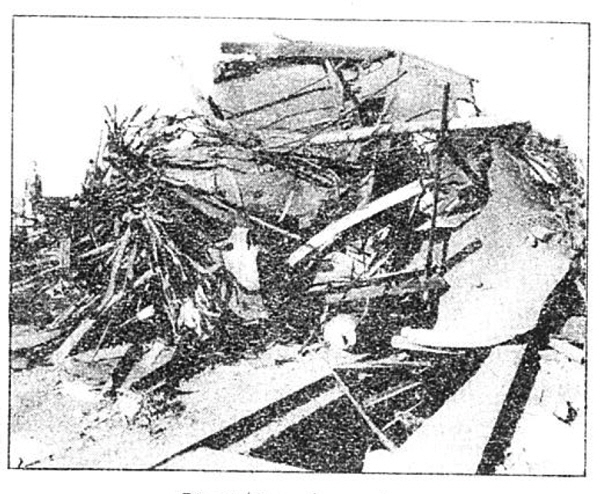
Photo Caption: Direct hit on locomotive.
Don't think that the '76 wasn't hep to what had been going on in France. The 1700s had felt the strange, cold excitement that greeted the June D-Day when Allied troops poured onto the beachheads of Normandy, the anxious but determined tension through the long weeks of grim battle along the coastal lines. They noted with pride that General Burpee's 2nd Military Railway Service was facing its problems and hazards like veterans. When, on August 15th, landings were made along the Riviera beaches for the other jaw of the nutcracker that was to give the Germans a disasterous squeeze, the 1700s told themselves, "This is getting close to home."
When Lt. Col. Benjamin H. Decker, General Gray's executive deputy and a former D&RGW division superintendent from Salt Lake City, landed on the Riviera beach on August 16th, he immediately began a survey of the railroad situation.
[p. 23]
Next day an Engineer battalion placed some empty cars for loading at St. Tropez. The day after that, six carloads of supplies were moved from St. Tropez to Cogolin, about 15 miles from the beach. The following day it was eight carloads. And so the flow of traffic started, eventually reaching 14,000 tons daily and the top isn't yet in sight.
A reconnaissance party found 12 locomotives and 80 freight cars at Carnoules, northeast of Toulon, and they were rushed into service. It was apparent that only about 10 per cent of the locomotives which existed before the war were still available; rolling stock was down from about 440,000 to around 200,000, even including the German cars that fell into Allied hands.
To supplement this supply, it was decided to bring in, as quickly as possible, a number of standard oil-burning locomotives and Diesel-electric switch engines, along with some 1,000 special-type cars from North Africa. These included 10,000-gallon tank cars, 56-ton war flats to carry tanks and other heavy equipment, refrigerator cars, etc.
The first MRS units to take the field in Southern France included a forward echelon of Headquarters, followed later by the entire outfit; the 703rd Grand Division, 713th Operating Battalion and the 794th MPs.
After them came the 727th and 759th Operating Battalions, the 704th Grand Division, the 788th Base Depot Company, and the 761st Railway Transportation Company. Remaining in Italy to continue supplying the Allied Armies there were the 701st Grand Division, the 715th and 719th Operating Battalions, the 753rd Shop Battalion, the 760th Diesel Battalion, and the newly arrived 774th Grand Division.
Three new units were added to General Gray's command, now known as the 1st Military Railway Service, for duty in France. They were the 750th Operating Battalion, the 756th Shop Battalion, and the 783rd Base Depot Company. The 794th MP Battalion was augmented by assignment of the 388th and 400th MP Battalions.
For the soldier-railroaders who had worked their way across North Africa and up through Italy, conditions in southern France were an old story, with just a few new twists thrown in.
A great number of bridges had been destroyed. In the valley of the Rhone, from Marseille to Lyon, there were no connections between the right and left banks of the river. In one viaduct, commanding almost all the traffic of Western France, 22 out of 32 arches had been blown. To the north of Lyon, the situation was no better. Bridges, tunnels, stations, engine sheds, block cabins and freight sheds had been turned into rubble either by Allied bombing or German demolition.
Terrific damage had been inflicted on the marshalling yards all the way from the Mediterranean to the heart of France. Only chaotic heaps of burnt cars, smashed engines and twisted rail remained. Cleaning them up was slow work, with most of the necessary materials on the critical list.
[p. 24]
In both the repair and operation of rail lines in Southern France, the MRS received help of the 7th Army Engineers and unqualified cooperation from French railroad employees, members of the Societe Nationale des Chemins de Fer (SNCF).
Original plans called for establishment of three phases for the operation of railroads in France, subject always to U. S. control: (1) Operation by american Military; (2) French civilian operation, with U. S.
supervision; and (3) Complete operation by French civilians.
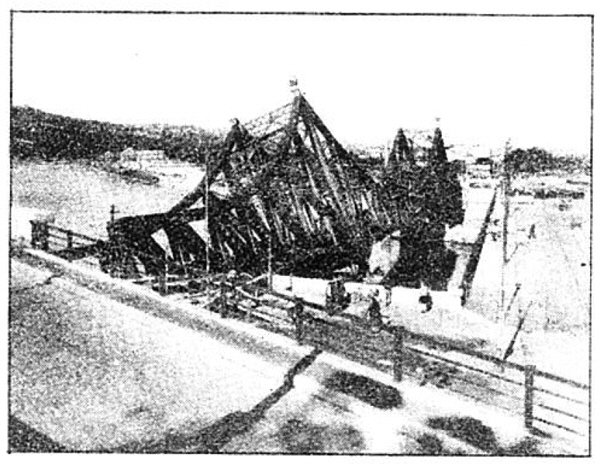
Photo Caption: Wrecked railroad bridge across Soane river at Lyon, France.
"From the very first," commented General Gray, "the desire of the SNCF to cooperate was so wholehearted that it was possible for us to skip the first phase altogether. So we started right in on the second step, with the French civilians doing the operating and our GIs just supervising - double-crewing on the runs. This supervision has naturally varied a lot, depending on the amount of traffic and proximity of trains to the front lines. Sometimes, none at all is necessary."
('76 appreciated French cooperation. Their equipment had air brakes. "Just like a breath from home," murmured '76.)
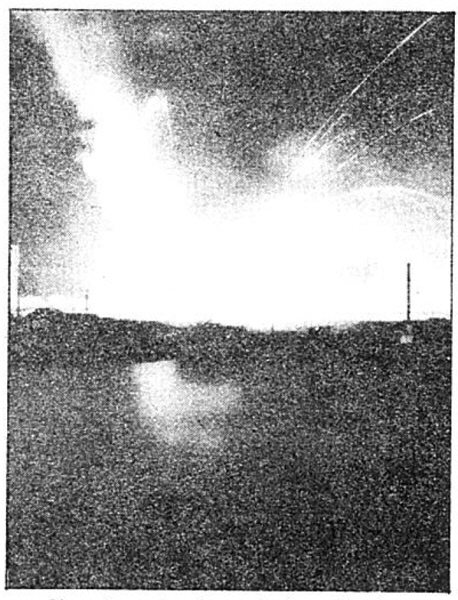
Photo Caption: Phosphorus bombs explode on burning ammo train.
Mutual assistance from all sides was an outstanding factor from the very beginning in getting the rail supply lines into action. With vital bridges out of commission, American 7th Army Engineers and the Civil Engineering Department of the SNCF worked right alongside MRS construction troops in order to open a route to the front with the least possible delay. By the first of the year, 42 bridges had been rebuilt; 800 miles of track and 4 tunnels repaired; 4000 miles of track were in operation by 1st MRS. Often a bit of improvising became necessary to link severed bits of rail line together pending repair of the crossings. For instance, on the first line to operate after D-Day, from the Riviera north to Grenoble, a blown-out bridge made it necessary to bring supplies by train up to the bank of the Durance river, ferry them across, and reload on a train on the other side.
[p. 25]
From there they proceeded as far as Sisteron where they had to unload again and truck around a demolished trestle.
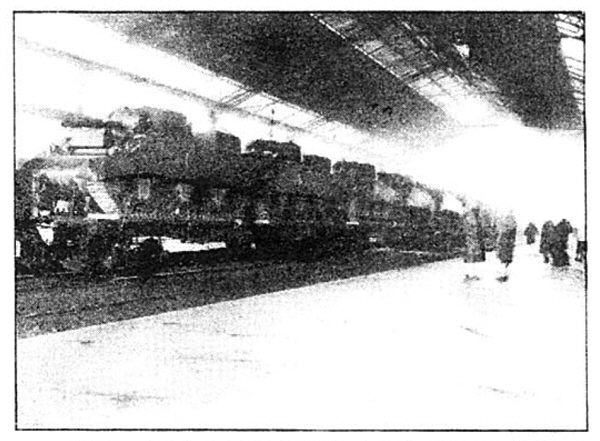
Photo Caption: Tanks move from ports to battle lines in USA car flats.
Repairing battered communications lines along the right-of-way also required its share of cooperation and ingenuity. French railway and U.S. Signal Corps men worked side by side with Signal groups of the MRS to put back into service the telephone and telegraph facilities so systematically destroyed by the retreating Germans.
While that was going on, short wave radio stepped in to play a very vital part in keeping the trains moving. Set up readily at points along the line, the portable radio outfits of the 794th MPs moved in quickly wherever regular ground communications were inoperative. General Gray term the radio "life saver", pointing out that without it there would have been continued instances like the one very early in the campaign when 21 trains were out on the road, but only eight of them could be positively accounted for. The other 13 were on their own.
End-to-end train communication gave radio another chance to prove its worth. Already in the experimental stage back home in America, the idea got its first overseas trial on an MRS train in France on a test run made by two 713th railroaders - S/Sgt. Ray Welker of Portland, Oregon (Southern Pacific). and T/4 Charles H. Sample, Jr., Altoona, Pa. (PRR). "We knew that having both ends of the train in communication would eliminate a lot of hazards and save a lot of time," the men explained, "but we were somewhat handicapped in setting up a system due to the fact that no type of permanent installation could be made on the rolling stock, and the expense had to be practically zero."
"So we borrowed a couple of 'walkie-talkie' sets, put one in the cab and the other in the caboose, and started out. We made a 90-mile trip, and were in perfect communication with each other at all times, except for a few minutes when passing through a tunnel"
"At one station where we had to make a lay-over, we tried out the possibilities of radio for yard operations with much success. Now the yard men are all clamoring for it."
[p. 26]
All these achievements in opening and maintaining the railroad system in southern France soon brought a special commendation to the 1st Military Railway Service from Lieutenant General Jacob L. Devers, Commanding General of the Sixth Army Group, "Supplies carried by your group are now reaching the forward areas," the general said. "There could be no finer compliment to pay than to say you have the thanks and appreciation of every individual soldier receiving these supplies."
Over and under and behind the realm of military effort flows another stream of consciousness that makes up the everyday of MRS. Out of that stream protrude countless little incidents that tell of the ingenuity, kindliness and humor of soldier-railroaders, and their efforts to fill the gaps left by their separation from family, friends and familiar environment.
In the MRS soldier-railroader's hours off-duty. sports and hobbies flourish to an unusual degree, ranging from a football team that won the 1945 Riviera Bowl game, to a male chorus that for months was a weekly feature on the Radio France station in Algiers. Artists try their brushes and pens on the vivid scenes of military railroading; musicians seek out instruments wherever they go, pouring forth everything from Brahms to Boogie-woogie. A draftsman builds a model of a bridge that has captured his imagination, putting it together to perfect scale with bits of cardboard, match sticks and glue.
Catching runaway barrage balloons isn't railroading, but six MRS soldiers did their duty when one of the big rubber cows came bouncing down the tracks playing tag with the locomotives in the Algiers yards. The six cowboys were S/Sgt. Branch, Sgt. Keiser and T/5 Danihy of the 759th, Pvt. Crumley, Pvt. Dodds, and Pvt. McCarthy of MRS headquarters. Since the balloon was highly inflammable and the men knew it, they were cited by General Gray.
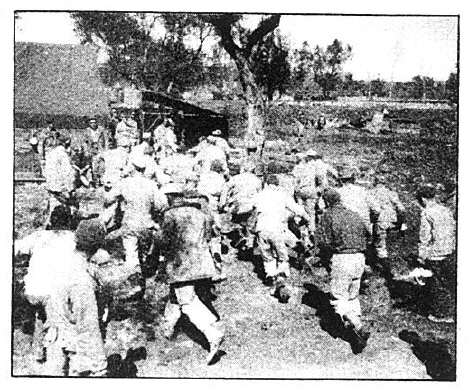
Photo Caption: Outa my way! It's time for chow!
The 719th's T/4 Dan Lawyer gained immortality in his unit by constructing an ice-cream freezer out of a worn-out gasoline generator, some scrap aircraft parts and an old milk can. To satisfy men who messed at road kitchens out along the line, the freezer became a traveling ice cream plant. A cook craves doughnuts, rolls the dough with a wine bottle, cuts them out with a sawed-off C-Ration can, and punches the holes with a bottle cap. A washing machine suddenly materializes out of miscellaneous drums, scrap gears and pipe (not out of chewing gum wrappers, an abandoned Rolls-Royce and the teeth of a defunct camel, as it was rumored), and is christened "Hoffman's Invasion Machine" after its inspired inventor.
[p. 27]
T/4 Dusina, T/5 McCafferty, and PFC Dwyer found a stranger in the cab of their locomotive, busy pulling at miscellaneous levers to get it started. With visions of saboteurs floating before their eyes, the three hauled him off to the MPs, only to find out he was a merchant seaman who, spurred on by a bit of potent North African red wine, wanted to see the countryside and felt that a locomotive was just about his size.
Christmas rolls around, and the soldier-railroaders celebrate it in traditional style. Rounding up all the French or Italian kids in the vicinity of the bivouacs and billets, the shower them with "camp-made" toys, and with candy and chewing gum contributed for months ahead from PX rations. It pays off big dividends in ecstatic looks from bug-eyed kids, and makes Christmas out of 25 December.
753d's "C" Company refitted a salvaged Italian passenger car with all the equipment and appurtenances for the large-scale manufacture of doughnuts. Red Cross girls took over its operation, and it travels up and down the railroad lines dishing out cheer for the inner man to soldier-railroaders stationed at isolated spots a long way from Red Cross Clubs and moving pictures. The car is known as the "Yankee Dipper".
A little drama was enacted in Southern France, where there were reports that German paratroopers had been dropped in the hills. Sgt. Skolrood of the 713th remarked to PFC Robinson and Pvt. Clatterbuck that it might be a good idea to keep their eyes open for trespassers.
Time passed, and preoccupied with their work none of them noticed a man in a gray uniform until he darted between some cars. Skolrood yelled at Robinson, Robinson yelled at Clatterbuck, and Clatterbuck just yelled. Meanwhile they managed to level off the .45s and began an encircling movement. The German gave up and came out shouting "Kamerad"".
Robinson noticed three or four potato-masher grenades hanging from the Jerry's belt, and steadied his pistol for a quick one-two but the man in gray mumbled something the sounded like "don't shoot", so they took him him alive. The got a tub-full of small arms and grenades off the prisoner.
Discussing the incident, Robinson observed "Aw, it was just one of those things that keep happening to the 713th."
Said Clatterbuck: "Yeah, that was small potatoes. Why, I remember when we first hit Italy on the heels of the Fifth Army ... The bullets and shrapnel were whistling around ..." "Aw, quit braggin'," said Skolrood.
[p. 28]
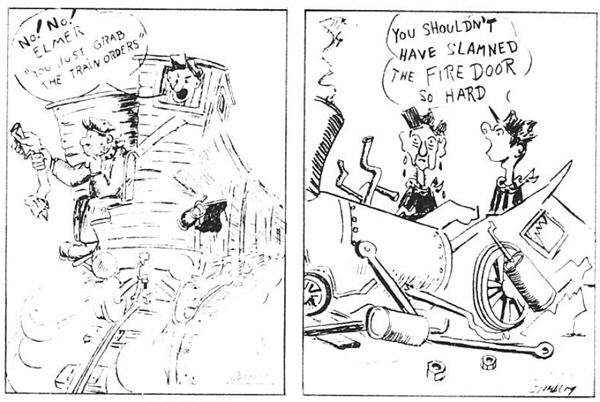
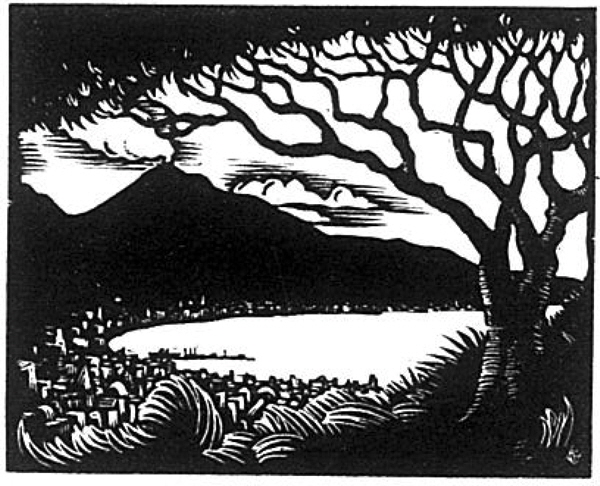
A block print by T/5 N. E. Kernall.
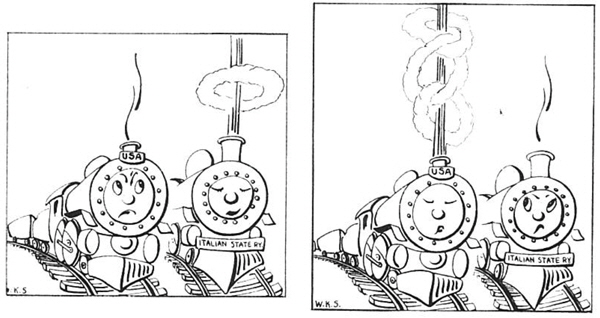
[a page of assorted cartoons ]
[p. 29]
We can't call this "finis"; the story doesn't end here. But as our words turn into type, realization of the principles that our nation has stood for and the objectives it has worked and fought for looms large on the horizon. MRS continues to put forth its utmost, in Italy, in France, to fulfill its obligations as soldiers and railroaders toward the realization of those ideals and objectives.
Our three 1700s didn't start out to be symbols - nothing ever does - but they have become that. '77 is back there in North Africa, where it was felt she could do more good in the prosaic zone of peace than in the more adventurous battle areas. '75 has sworn undying allegiance to the Allied Armies fighting the unspectacular but vitally important battle of North Italy; she intends to fight it out on that line if it takes all summer. The '76 is straining every steel sinew to get more and more and still more supplied to the vast armies locked in conflict at the western gates of Germany. We might go even further and say that to every Nazi who has ever read an un-Goebbeled American History, 1776 will have a meaning that he won't like.
Locomotives don't go in much for poetry, the written kind, that is. But one black night '76 tied up at a way station with a string of empties to await the passage of one of her northbound sisters with more urgent business. She awoke from a cat-nap just in time to catch a few words off the hind-end of a poem someone off in the darkness was reading. It stuck in '76's mind somehow ...
" ... strong in will,
to strive, to seek, to find, and not to yield."
"I'll have to remember that," thought '76. "That's right down our main line."
|
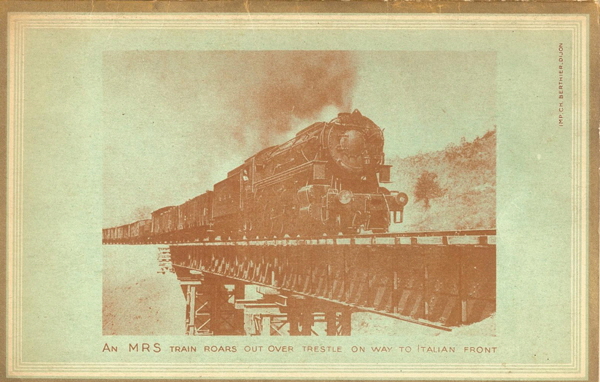
| Home EN Italy at war Military Railway Service |